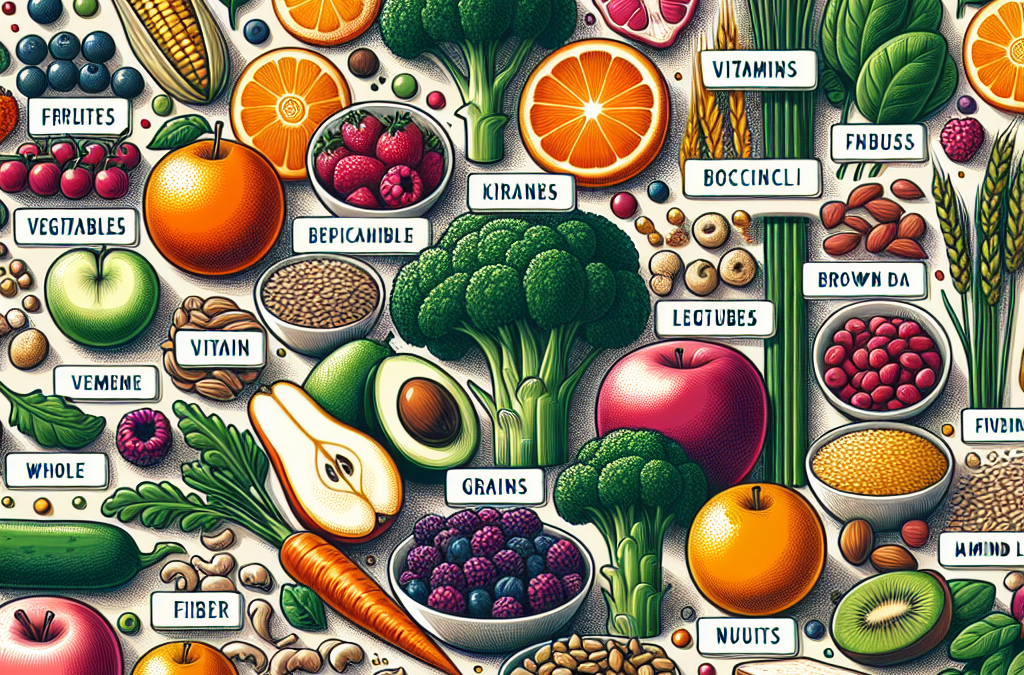Balancing Macronutrients: Protein, Carbohydrates, and Fats
The Importance of Protein
Protein is one of those buzzwords we all hear about when discussing nutrition. From my experience, it’s essential for repairing tissues and building muscles, especially if you’re active. Whole food sources such as beans, lentils, nuts, and lean meats provide not only the protein we need but also come packed with other vital nutrients.
When I incorporate protein into my meals, I like to think beyond just meat. For instance, mixing chickpeas into salads or using quinoa as a base can really up my protein intake without even trying too hard. Plus, plant-based proteins are often high in fiber, which is a big win for digestion!
So, when planning your meals, think about including a source of protein in every meal. It doesn’t have to be a lot; a handful of nuts, grilled chicken, or a scoop of Greek yogurt will do just fine.
The Role of Carbohydrates
Carbohydrates often get a bad rap, but let me tell ya, they are truly your body’s main source of energy. The key here is to choose the right carbs. Whole grains, fruits, and veggies are where you should be directing your focus. I’ve learned that complex carbohydrates like brown rice and oats not only keep you full longer but also help in providing sustained energy through the day.
I love mixing steamed veggies with a side of quinoa and calling it a day! That combo is not only delicious but also packed with nutrients. Sometimes, I find myself experimenting with different grains and finding creative ways to incorporate them into my meals.
Remember, it’s all about moderation and balance. Carbs are not the enemy; they’re part of a healthy lifestyle when chosen wisely! Keep those whole foods front and center.
Don’t Forget Healthy Fats
Let’s talk fats, the good kind! Eating healthy fats from foods like avocados, olive oil, and fatty fish has become a staple in my diet. They’re crucial for brain health and help to absorb fat-soluble vitamins. I find that adding a drizzle of olive oil or a slice of avocado takes my salads to a whole new level.
What’s more, mixing healthy fats with other food groups can help with satiety. For example, adding some nuts to a bowl of mixed greens makes for a filling meal or snack. I can recall times when I’d be ravenous after lunch, but ever since I’ve discovered the power of healthy fats, I stay full for longer.
So, when you choose your meals, aim to include fats in a balanced way; they’re your allies in keeping you satisfied and nourished!
Maximizing Micronutrient Intake
Load Up on Vegetables
Whenever I’m crafting a meal, the more colors on my plate, the better! Vegetables are a powerhouse of essential vitamins and minerals. Leafy greens like spinach and kale, for instance, are loaded with nutrients that you don’t want to miss out on.
I love jumping into the produce section and selecting a rainbow of veggies—think bell peppers, carrots, broccoli, and beets! This not only makes for a visually appealing dish but also ensures I’m getting a range of benefits in one meal.
It’s fascinating how different veggies provide different nutrients. So, don’t settle for just one or two. Diversifying your choices can lead to a healthier you. Roasting a mix of your favorites with some spices is a game changer!
Fruits for the Win
The sweet stuff! I’ve always got a stash of fruits on hand because they’re nature’s candy and incredibly nourishing. Fruits are rich in vitamins, antioxidants, and fiber, which makes them a perfect snack or dessert substitute. Berries are my go-to because they pack a punch in terms of flavor and nutrients.
I enjoy tossing some berries into my morning oatmeal or blending them into smoothies for a refreshing treat. Not only do they taste great, but the antioxidant boost helps combat oxidative stress in the body.
Trying to eat in-season fruits can also make a difference in taste and nutrition. It’s amazing how good a ripe peach or zesty grapefruit can be in the right season. Keeping things fresh is key!
Utilizing Herbs and Spices
Herbs and spices are seriously underrated! They can elevate the nutritional profile of your meals without adding any extra calories. From my cooking experiences, I’ve learned that fresh herbs like cilantro and parsley add vibrant flavors and a ton of added micronutrients.
Experimenting with spices like turmeric and ginger has not only enhanced my dishes but provided substantial anti-inflammatory benefits too. The more I cook, the more I enjoy discovering new flavor profiles! Plus, they can make even the simplest meals taste gourmet.
So don’t shy away from getting creative with your spices and herbs; they’re a game-changer for nutrient density in your meals!
Understanding Food Pairing
Combining for Nutrient Absorption
Did you know that certain foods work better together? For example, pairing vitamin C-rich foods, like oranges, with iron-rich foods, such as spinach, can enhance absorption. I incorporate this in my salads all the time, adding slices of oranges to a bed of spinach for that extra kick.
Get an Amazing Discount on the Best Certified Organic Whole Food Supplement!
Another combo I love is pairing healthy fats with greens. When I make a salad, I always drizzle olive oil or toss in some nuts. The fats help absorb the vitamins within the leafy greens more effectively. It’s like a little science experiment in my kitchen!
Understanding these pairings has shifted my approach to meal prep, pushing me toward more thoughtful combinations that really do wonders for my health!
Bringing it Together in Meals
Food doesn’t have to be complicated to be nutritious. Think of building a plate where each section complements the other. My favorite way to combine whole foods is by creating bowls—be it a grain bowl, salad bowl, or even a smoothie bowl!
I start with a base of whole grains or leafy greens, then I layer on proteins, healthy fats, a variety of veggies, and finally, add a sprinkle of herbs or seeds. It feels good to know that every bite has multiple nutritional components working for me!
The best part? These bowls are incredibly customizable based on what you have around. It can be a delightful adventure trying new combos every week!
Mindful Eating for Optimal Nutrition
Savoring Every Bite
One of the easiest things I’ve done to improve my eating habits is to slow down. Taking the time to really savor my food not only enhances my experience but I find that it helps with digestion. Eating mindfully allows me to appreciate the flavors and textures, leading to satisfaction with smaller portions.
I often practice this by putting my fork down between bites or chewing more thoroughly. It’s surprising how much more enjoyable meals become when I’m not rushing through them!
Mindfulness in eating can also help me tune into my hunger signals. I’ve learned to tell when I’m genuinely satisfied instead of just full, leading to better choices for my body.
Listening to Your Body
Your body knows best! It’s become super important for me to listen to what my body needs. Some days, I crave more carbohydrates, while others, my body is asking for extra protein. By paying attention to these signals, I can make healthier choices that suit my needs.
On days when I’m feeling sluggish, for instance, I might opt for a refreshing smoothie with a good protein source, while on more active days, I lean towards heartier meals that will sustain my energy levels.
Developing a deeper relationship with what I eat has enriched my culinary experience and boosted my overall wellness!
The Importance of Hydration
Last but not least, hydration! Sometimes I forget how crucial water is for nutrition. Staying well-hydrated can significantly impact my overall health, digestion, and even how my body absorbs nutrients from food. I keep a water bottle handy to remind myself to drink throughout the day.
Adding slices of fruit or herbs isn’t just for aesthetics; it’s a nice way to flavor water and enjoy even more nutrients! Personally, I love adding cucumber and mint for a refreshing drink.
Staying hydrated often means I feel better and make better food choices. It’s simple, but it makes a world of difference!
Frequently Asked Questions (FAQ)
1. How can I start combining whole foods effectively?
Start by understanding the basics of macronutrients. Focus on incorporating a variety of proteins, complex carbohydrates, and healthy fats in every meal. Experiment with different combinations to find what tastes best for you!
2. What are some examples of nutrient-dense food combinations?
Some great combos include spinach with mandarin oranges for vitamin C and iron absorption, and salmon paired with quinoa and veggies for a hearty dinner!
3. Why is mindful eating important?
Mindful eating can enhance your meal experience, help you tune in to your body’s hunger signals, and promote better digestion by slowing down your eating pace.
4. Are there specific herbs or spices I should always include?
Fresh herbs like basil, cilantro, and parsley are lovely for adding flavor and nutrients. Spices such as turmeric and ginger are great for their anti-inflammatory properties and should definitely be in your kitchen!
5. How does hydration affect my nutrition?
Proper hydration is key to nutrient absorption and overall health. Drinking enough water can improve your digestion and boost your energy levels, ensuring your body can utilize all those important nutrients effectively!




